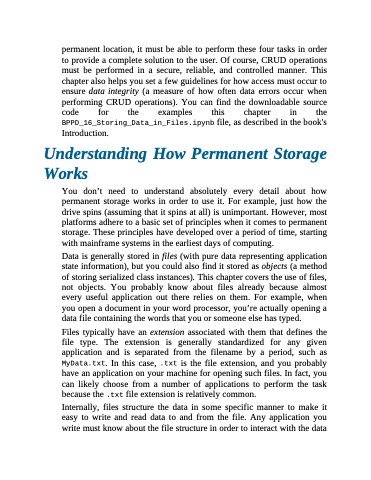Page 366 - Beginning Programming with Pyth - John Paul Mueller
P. 366
permanent location, it must be able to perform these four tasks in order to provide a complete solution to the user. Of course, CRUD operations must be performed in a secure, reliable, and controlled manner. This chapter also helps you set a few guidelines for how access must occur to ensure data integrity (a measure of how often data errors occur when performing CRUD operations). You can find the downloadable source code for the examples this chapter in the BPPD_16_Storing_Data_in_Files.ipynb file, as described in the book's Introduction.
Understanding How Permanent Storage Works
You don’t need to understand absolutely every detail about how permanent storage works in order to use it. For example, just how the drive spins (assuming that it spins at all) is unimportant. However, most platforms adhere to a basic set of principles when it comes to permanent storage. These principles have developed over a period of time, starting with mainframe systems in the earliest days of computing.
Data is generally stored in files (with pure data representing application state information), but you could also find it stored as objects (a method of storing serialized class instances). This chapter covers the use of files, not objects. You probably know about files already because almost every useful application out there relies on them. For example, when you open a document in your word processor, you’re actually opening a data file containing the words that you or someone else has typed.
Files typically have an extension associated with them that defines the file type. The extension is generally standardized for any given application and is separated from the filename by a period, such as MyData.txt. In this case, .txt is the file extension, and you probably have an application on your machine for opening such files. In fact, you can likely choose from a number of applications to perform the task because the .txt file extension is relatively common.
Internally, files structure the data in some specific manner to make it easy to write and read data to and from the file. Any application you write must know about the file structure in order to interact with the data


